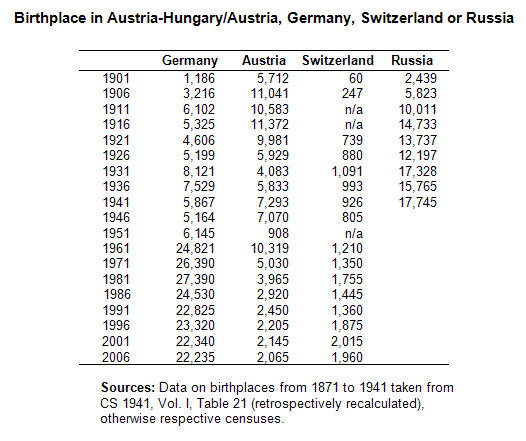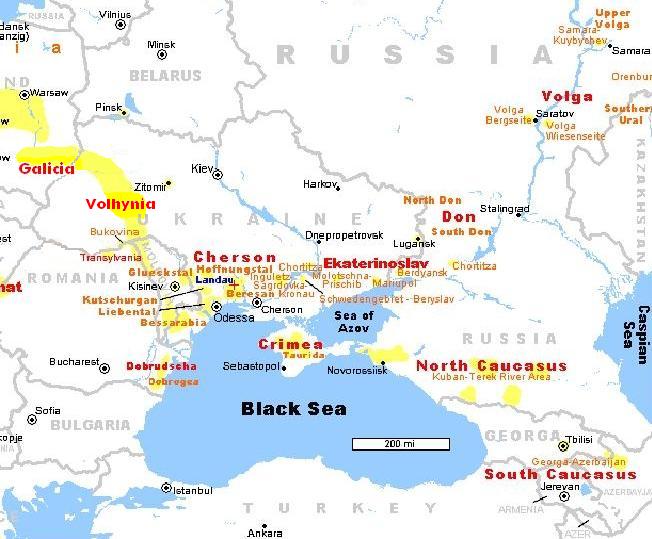
The geographical origin of the German-speaking immigrantsBrief reference has been made to some of the immigrants' origins, e.g., Volhynia and Galicia. The following table shows the numbers of Albertans who were born in Austria-Hungary (later Austria), Germany, Switzerland, and Russia; it illustrates the size of the Russian group compared to the numbers of Albertans born in Germany or Austria. Note the huge increases in immigration to Alberta from the Austro-Hungarian Empire and the Russian Empire between 1901 and 1906 and again by 1911, most of whom were ethnic Germans and had German as their mother tongue. Why did so many speakers of Germans from Central and Eastern Europe decide to come to Canada?  Settlement in Central and Eastern EuropeLong before Catherine the Great invited Germans to come to Russia in 1763, German workers and traders had already enjoyed certain privileges there: Ivan the Terrible (1553-1584) had invited Germans with specialized occupations and trades to work in Russia, and Peter the Great (1672-1725) had invited Germans to Russia to help him modernize his backward country. But large-scale immigration began when German peasants were invited to settle in Russia by Catherine the Great and, later, by Czar Alexander I. where they settled in three main areas of the Russian Empire—the Volga, the Black Sea coast, and central and southwestern Poland, especially Volhynia. In 1763, the Tsarina issued an invitation and a manifesto that brought many Germans to the Volga region in the subsequent five years. By the end of 1767 German settlers, coming primarily from central Germany, had organized more than one hundred colonies along the Volga River, near Saratov. By 1869, the German population in the Volga region exceeded 250,000. Tsar Alexander I.'s Manifesto also attracted large numbers of Germans to southern Russia between 1804 and 1842. Several major colony groups were founded in the Black Sea region and extending into the Crimea and to the Caucasus. The Black Sea Germans came primarily from southern Germany, but a substantial number (Mennonites) came from the Danzig area in Prussia. About 80,000 Germans settled in the Black Sea region between 1804 and 1850; another 30,000 Germans immigrated to the Ukraine Black Sea region between 1830 and 1865. Over 150,000 emigrated to Volhynia between 1865 and 1875. By 1897, the German settlers in Volhynia numbered 170,000 in 139 villages. By about 1870, the immigrants and their descendants numbered 450,000. By 1897, 1.8 million ethnic Germans were living in the Russian Empire. Their economic success and constant need for land brought one third of South Russia's arable land under their control. 
Source: Adapted from http://www.rollintl.com/roll/grsettle.htm. Note: Locations approximate Among the most important reasons for inviting the Germans to Russia were the need to colonize a vast, empty part of Russia and to bring in people who could serve as good examples in agriculture and other specialized occupations and trades. The settlers left various regions in Germany to escape wars, political oppression and foreign occupation, strict and often unjust government, military service and forced labor, high taxation, poverty and disease, religious and political persecution, and they always found themselves in desperate need for land. Here they would be guaranteed freedom of religion, exemption from military service, the right to use their own language, the right to build their own villages, churches, and schools, as well as certain tax exemptions and some free land and cash grants. [See details on the German settlement in Central and Eastern Europe.] Immigration to Alberta from Central and Eastern EuropeIn the 1870s, the liberal reforms of Czar Alexander II. and an increasing sense of Russian nationalism, combined with restrictive legislation for the Germans, prompted the settlers to leave for land elsewhere. In Volhynia, laws forbade the sale of land to anyone but native Russian citizens although the settlers had been invited to lease and cultivate undeveloped land since the 1830s. As conditions deteriorated for the settlers, North America became the new promised land. Canada and the United States issued their own invitations to settlers and sent recruiters to Europe. Just as the Russian government had attracted Germans with free land and special rights, the governments of this New World made similar offers less than a century later. About 300,000 Germans left Russia to seek land and freedom in the Americas. According to Canada's Dominion Lands Act of 1872, every immigrant could obtain for $10 a 160-acre homestead in the West, which became his property after three years if certain conditions were met. Through the efforts of Canada's land agents and intensive recruitment advertising, the German people in Russia heard about these offers. The Prairies, like those in the Dakotas, resembling as they did the steppes of southern Russia, were to prove very attractive to many German Russians, especially Black Sea Germans. Thousands took up the invitation to come to Canada, especially between 1900-1913 when expanding railway branch lines made the Prairies readily accessible to new settlers. Some settlers migrated first to the U.S. before continuing on to the Canadian West; in fact, pne of the heaviest migration movements to Canada in that period was that of "German-Americans" streaming northward across the border—Germans from Russia who had first settled in the U.S. The emigrating Germans from Russia travelled by train across Europe to northern shipping ports. There they boarded huge ships as third-class passengers for trips across the Atlantic lasting nearly two weeks. Crammed below deck, they fought sea sickness and sometimes life-threatening disease. Many landed at Canadian ports of entry at Halifax or Quebec City before taking further long train rides aboard "colonist cars" to the Canadian West. There they began life's struggles all over again under the harsh Prairie conditions. Not all groups of the "Germans from Russia" who came to Canada settled in Alberta; many went to Saskatchewan and Manitoba. But about half of the Germans who settled in Western Canada in the pre-1914 era were from Volhynia [see details on the Germans from Volhynia and Russian Poland] and the colonies in Bessarabia [see details on the Germans from Bessarabia], the Odessa region, the Crimea, the shores of the Sea of Azov [see details on the Germans from Odessa and the Black Sea], and the banks of the Volga [see details on the Volga Germans]. In addititon to the Germans from Russia, thousands of German-speaking immigrants to Alberta came from the Austro-Hungarian Empire: Almost 20% of the total German immigration to western Canada before World War I originated in the non-German parts of the Empire, mainly Galicia [see details on the Germans from Galicia], the Bukovina [see details on the Germans from the Bukovina] and the Banat in southern Hungary (the Donauschwaben), where the Empire had settled them in the century before. Overpopulation, economic hardships, restrictions on the purchase of land, and political repression drove them into emigration. From among these three groups, it was mostly the Galicians who migrated to Alberta. Click here for maps of German settlements and Mennonite and Hutterite colonies in Alberta. |
